Environmental Engineering: Tidal Energy Generation and Impact Report
VerifiedAdded on 2020/02/23
|19
|4162
|327
Report
AI Summary
This report provides a detailed analysis of tidal energy, focusing on its generation, development costs, and various considerations for implementation. It explores how tidal power is harnessed from ocean tides to generate electricity, emphasizing the role of gravity from the sun and moon in creating tidal waves. The report discusses the high initial investment costs of tidal power plants compared to other renewable sources, while also highlighting their low operational costs and reliability. It covers the locations of tidal energy plants, including La Rance in France and the Sihwa Lake power station in South Korea, and addresses social and environmental impacts, such as effects on marine life, navigation, and the potential for noise pollution. Health and safety considerations, including the need for protective measures for workers and the environmental benefits of reducing reliance on fossil fuels, are also discussed. The report concludes by examining the economic benefits, such as job creation and revenue generation from tourism, while also emphasizing the need for safety protocols to mitigate risks associated with the operation of tidal power plants.
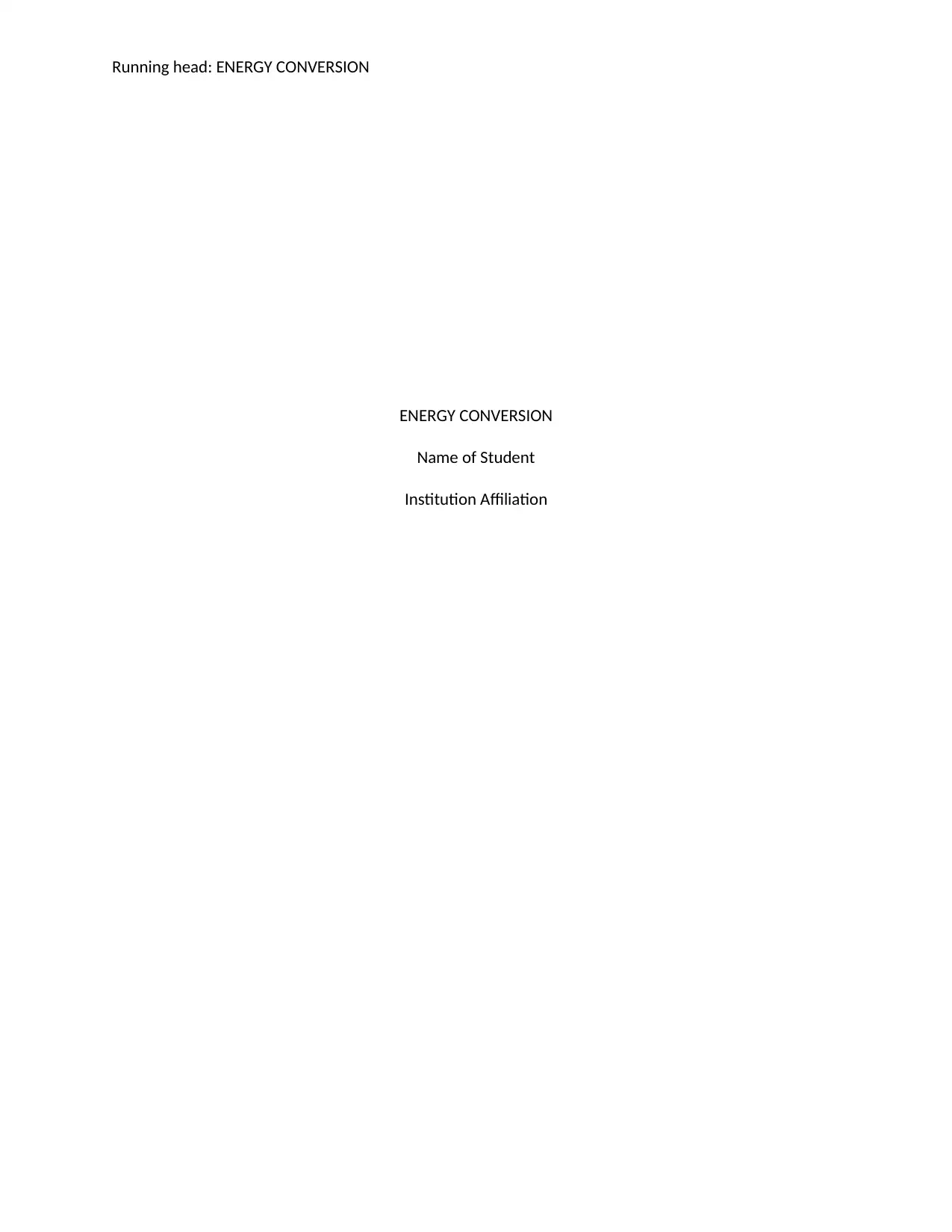
Running head: ENERGY CONVERSION
ENERGY CONVERSION
Name of Student
Institution Affiliation
ENERGY CONVERSION
Name of Student
Institution Affiliation
Paraphrase This Document
Need a fresh take? Get an instant paraphrase of this document with our AI Paraphraser
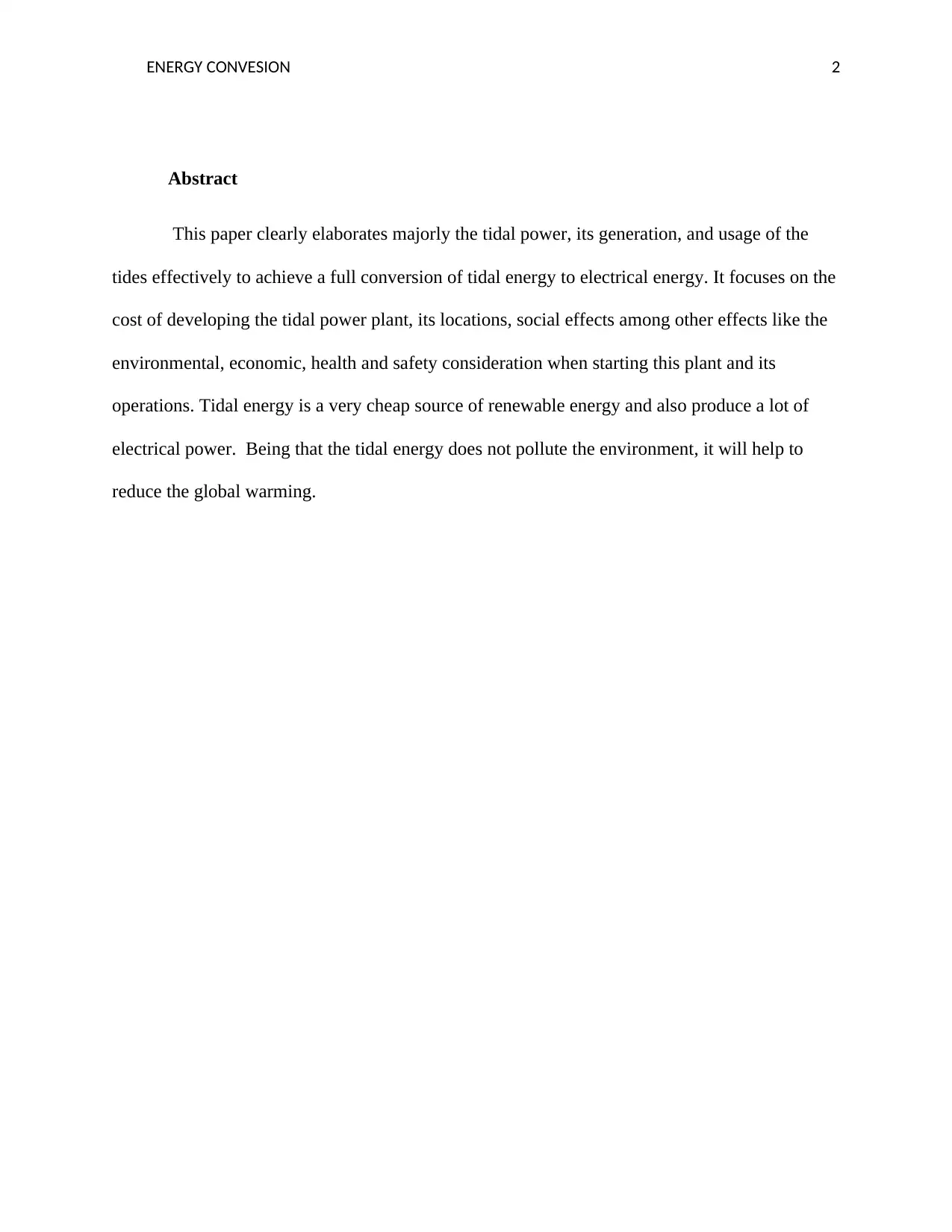
ENERGY CONVESION 2
Abstract
This paper clearly elaborates majorly the tidal power, its generation, and usage of the
tides effectively to achieve a full conversion of tidal energy to electrical energy. It focuses on the
cost of developing the tidal power plant, its locations, social effects among other effects like the
environmental, economic, health and safety consideration when starting this plant and its
operations. Tidal energy is a very cheap source of renewable energy and also produce a lot of
electrical power. Being that the tidal energy does not pollute the environment, it will help to
reduce the global warming.
Abstract
This paper clearly elaborates majorly the tidal power, its generation, and usage of the
tides effectively to achieve a full conversion of tidal energy to electrical energy. It focuses on the
cost of developing the tidal power plant, its locations, social effects among other effects like the
environmental, economic, health and safety consideration when starting this plant and its
operations. Tidal energy is a very cheap source of renewable energy and also produce a lot of
electrical power. Being that the tidal energy does not pollute the environment, it will help to
reduce the global warming.
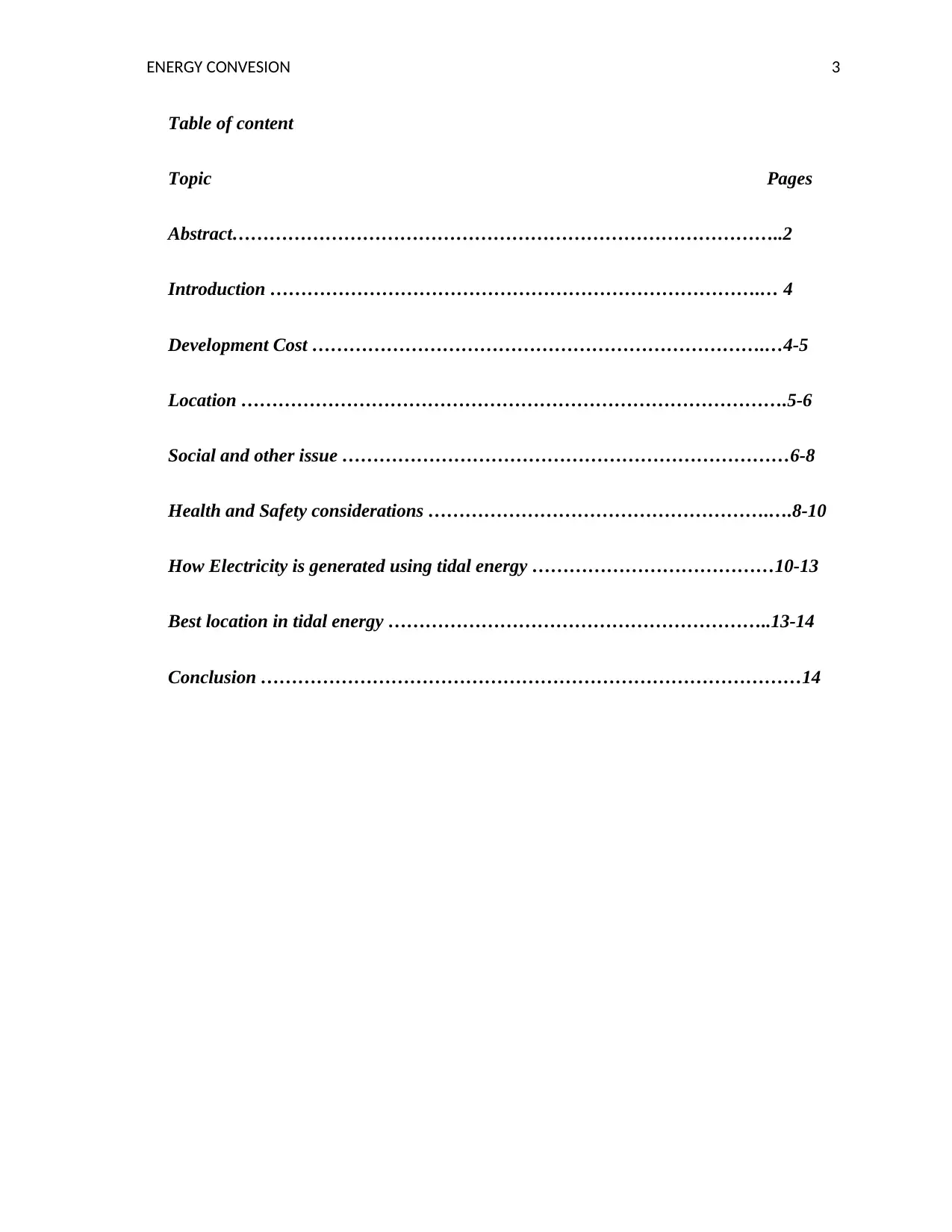
ENERGY CONVESION 3
Table of content
Topic Pages
Abstract……………………………………………………………………………..2
Introduction …………………………………………………………………….… 4
Development Cost ……………………………………………………………….…4-5
Location …………………………………………………………………………….5-6
Social and other issue ………………………………………………………………6-8
Health and Safety considerations ……………………………………………….….8-10
How Electricity is generated using tidal energy …………………………………10-13
Best location in tidal energy ……………………………………………………..13-14
Conclusion ……………………………………………………………………………14
Table of content
Topic Pages
Abstract……………………………………………………………………………..2
Introduction …………………………………………………………………….… 4
Development Cost ……………………………………………………………….…4-5
Location …………………………………………………………………………….5-6
Social and other issue ………………………………………………………………6-8
Health and Safety considerations ……………………………………………….….8-10
How Electricity is generated using tidal energy …………………………………10-13
Best location in tidal energy ……………………………………………………..13-14
Conclusion ……………………………………………………………………………14
⊘ This is a preview!⊘
Do you want full access?
Subscribe today to unlock all pages.

Trusted by 1+ million students worldwide
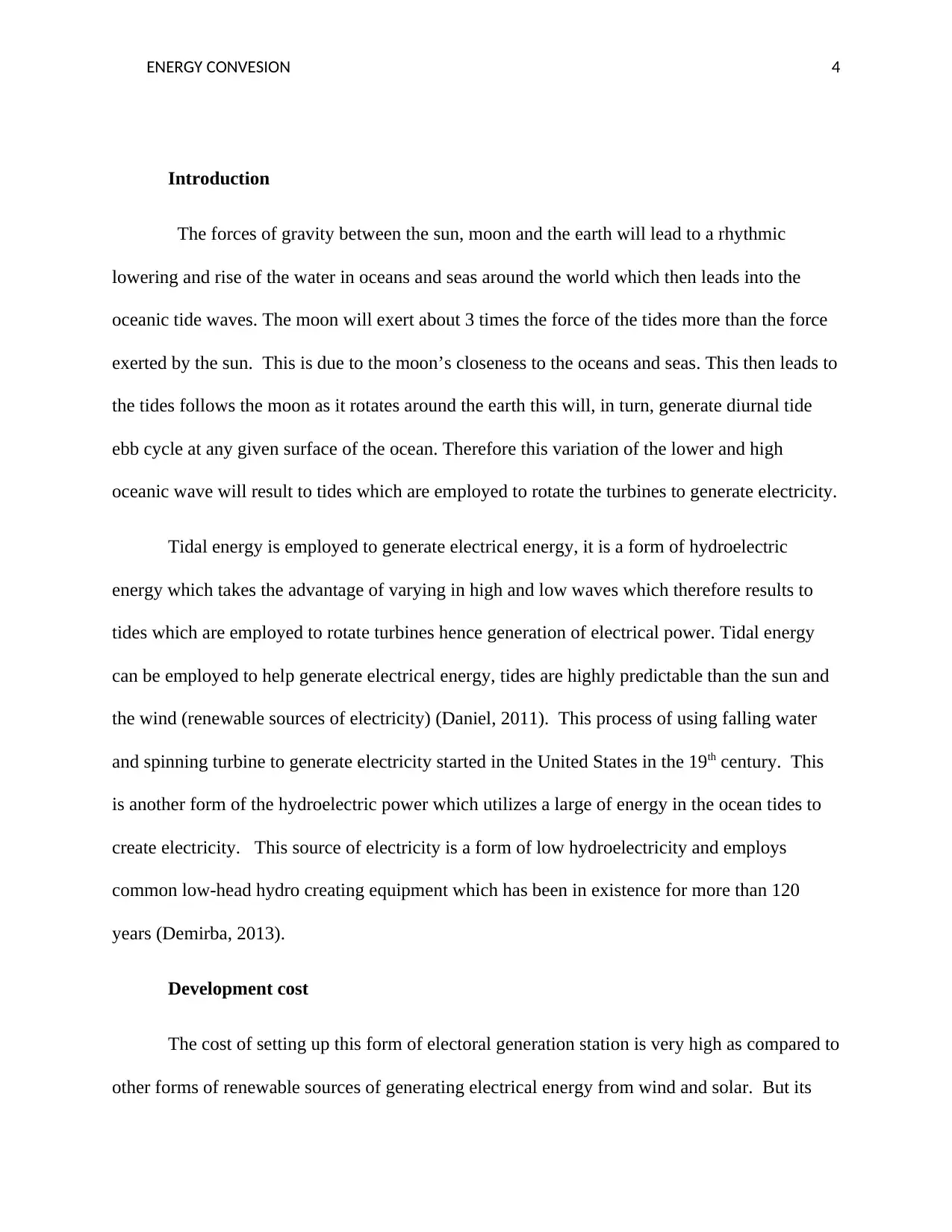
ENERGY CONVESION 4
Introduction
The forces of gravity between the sun, moon and the earth will lead to a rhythmic
lowering and rise of the water in oceans and seas around the world which then leads into the
oceanic tide waves. The moon will exert about 3 times the force of the tides more than the force
exerted by the sun. This is due to the moon’s closeness to the oceans and seas. This then leads to
the tides follows the moon as it rotates around the earth this will, in turn, generate diurnal tide
ebb cycle at any given surface of the ocean. Therefore this variation of the lower and high
oceanic wave will result to tides which are employed to rotate the turbines to generate electricity.
Tidal energy is employed to generate electrical energy, it is a form of hydroelectric
energy which takes the advantage of varying in high and low waves which therefore results to
tides which are employed to rotate turbines hence generation of electrical power. Tidal energy
can be employed to help generate electrical energy, tides are highly predictable than the sun and
the wind (renewable sources of electricity) (Daniel, 2011). This process of using falling water
and spinning turbine to generate electricity started in the United States in the 19th century. This
is another form of the hydroelectric power which utilizes a large of energy in the ocean tides to
create electricity. This source of electricity is a form of low hydroelectricity and employs
common low-head hydro creating equipment which has been in existence for more than 120
years (Demirba, 2013).
Development cost
The cost of setting up this form of electoral generation station is very high as compared to
other forms of renewable sources of generating electrical energy from wind and solar. But its
Introduction
The forces of gravity between the sun, moon and the earth will lead to a rhythmic
lowering and rise of the water in oceans and seas around the world which then leads into the
oceanic tide waves. The moon will exert about 3 times the force of the tides more than the force
exerted by the sun. This is due to the moon’s closeness to the oceans and seas. This then leads to
the tides follows the moon as it rotates around the earth this will, in turn, generate diurnal tide
ebb cycle at any given surface of the ocean. Therefore this variation of the lower and high
oceanic wave will result to tides which are employed to rotate the turbines to generate electricity.
Tidal energy is employed to generate electrical energy, it is a form of hydroelectric
energy which takes the advantage of varying in high and low waves which therefore results to
tides which are employed to rotate turbines hence generation of electrical power. Tidal energy
can be employed to help generate electrical energy, tides are highly predictable than the sun and
the wind (renewable sources of electricity) (Daniel, 2011). This process of using falling water
and spinning turbine to generate electricity started in the United States in the 19th century. This
is another form of the hydroelectric power which utilizes a large of energy in the ocean tides to
create electricity. This source of electricity is a form of low hydroelectricity and employs
common low-head hydro creating equipment which has been in existence for more than 120
years (Demirba, 2013).
Development cost
The cost of setting up this form of electoral generation station is very high as compared to
other forms of renewable sources of generating electrical energy from wind and solar. But its
Paraphrase This Document
Need a fresh take? Get an instant paraphrase of this document with our AI Paraphraser
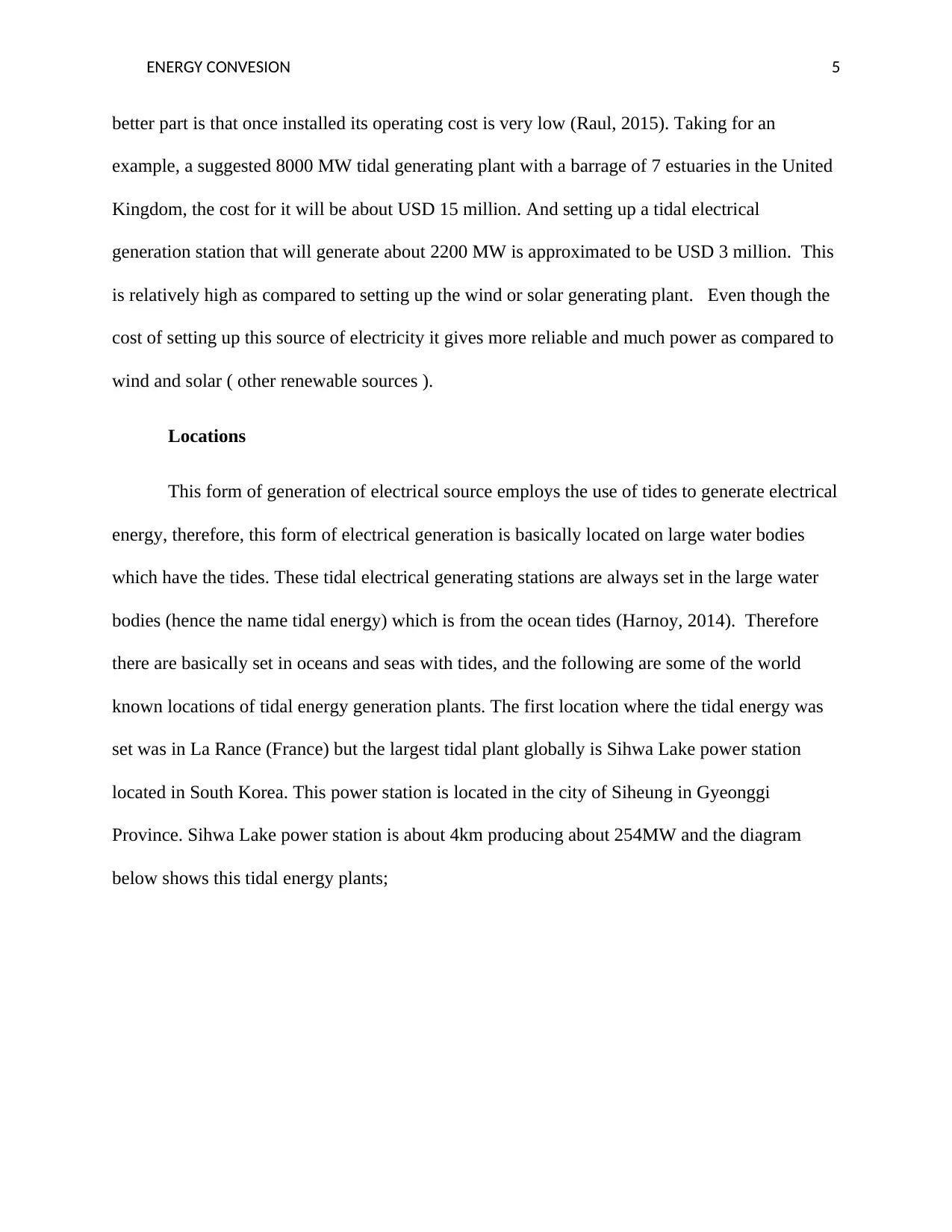
ENERGY CONVESION 5
better part is that once installed its operating cost is very low (Raul, 2015). Taking for an
example, a suggested 8000 MW tidal generating plant with a barrage of 7 estuaries in the United
Kingdom, the cost for it will be about USD 15 million. And setting up a tidal electrical
generation station that will generate about 2200 MW is approximated to be USD 3 million. This
is relatively high as compared to setting up the wind or solar generating plant. Even though the
cost of setting up this source of electricity it gives more reliable and much power as compared to
wind and solar ( other renewable sources ).
Locations
This form of generation of electrical source employs the use of tides to generate electrical
energy, therefore, this form of electrical generation is basically located on large water bodies
which have the tides. These tidal electrical generating stations are always set in the large water
bodies (hence the name tidal energy) which is from the ocean tides (Harnoy, 2014). Therefore
there are basically set in oceans and seas with tides, and the following are some of the world
known locations of tidal energy generation plants. The first location where the tidal energy was
set was in La Rance (France) but the largest tidal plant globally is Sihwa Lake power station
located in South Korea. This power station is located in the city of Siheung in Gyeonggi
Province. Sihwa Lake power station is about 4km producing about 254MW and the diagram
below shows this tidal energy plants;
better part is that once installed its operating cost is very low (Raul, 2015). Taking for an
example, a suggested 8000 MW tidal generating plant with a barrage of 7 estuaries in the United
Kingdom, the cost for it will be about USD 15 million. And setting up a tidal electrical
generation station that will generate about 2200 MW is approximated to be USD 3 million. This
is relatively high as compared to setting up the wind or solar generating plant. Even though the
cost of setting up this source of electricity it gives more reliable and much power as compared to
wind and solar ( other renewable sources ).
Locations
This form of generation of electrical source employs the use of tides to generate electrical
energy, therefore, this form of electrical generation is basically located on large water bodies
which have the tides. These tidal electrical generating stations are always set in the large water
bodies (hence the name tidal energy) which is from the ocean tides (Harnoy, 2014). Therefore
there are basically set in oceans and seas with tides, and the following are some of the world
known locations of tidal energy generation plants. The first location where the tidal energy was
set was in La Rance (France) but the largest tidal plant globally is Sihwa Lake power station
located in South Korea. This power station is located in the city of Siheung in Gyeonggi
Province. Sihwa Lake power station is about 4km producing about 254MW and the diagram
below shows this tidal energy plants;
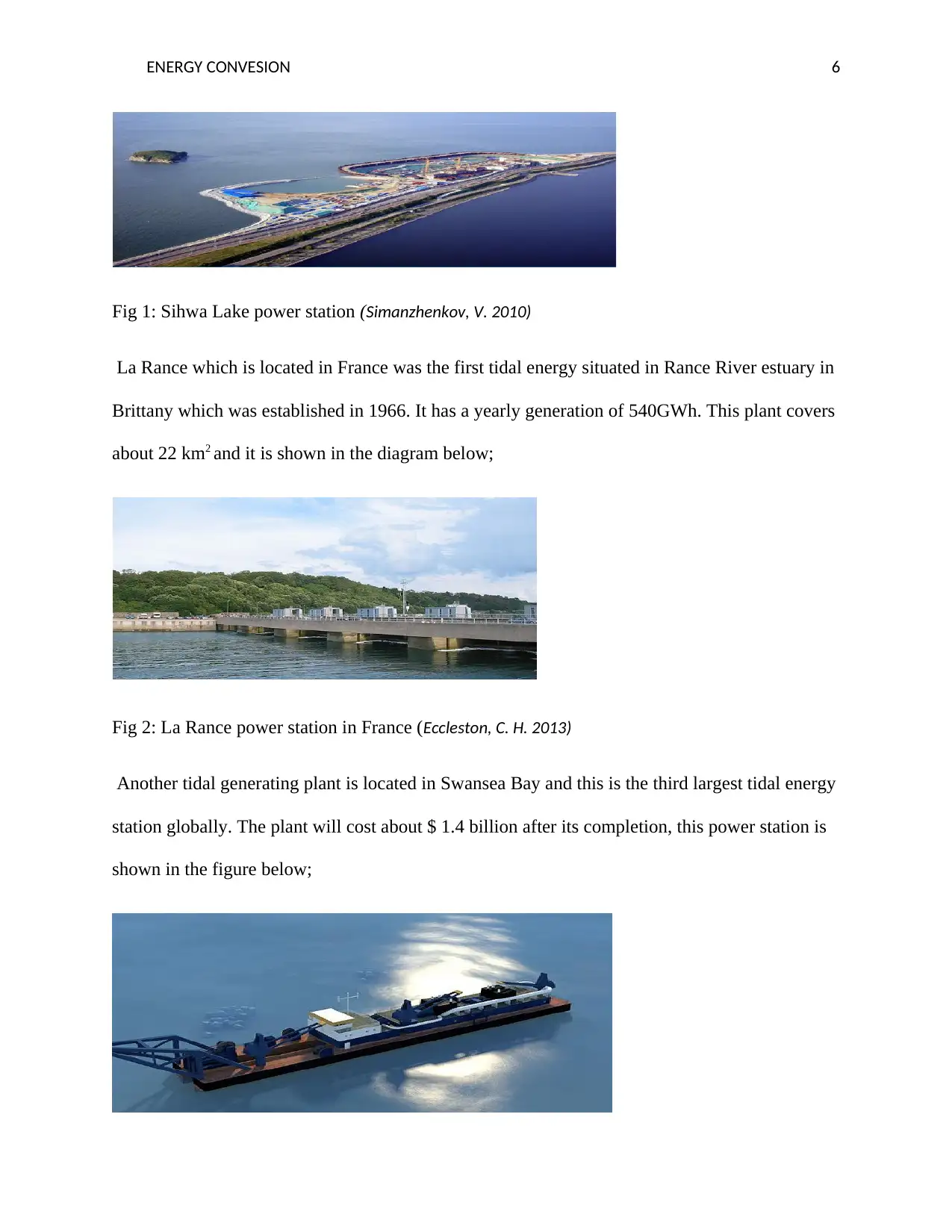
ENERGY CONVESION 6
Fig 1: Sihwa Lake power station (Simanzhenkov, V. 2010)
La Rance which is located in France was the first tidal energy situated in Rance River estuary in
Brittany which was established in 1966. It has a yearly generation of 540GWh. This plant covers
about 22 km2 and it is shown in the diagram below;
Fig 2: La Rance power station in France (Eccleston, C. H. 2013)
Another tidal generating plant is located in Swansea Bay and this is the third largest tidal energy
station globally. The plant will cost about $ 1.4 billion after its completion, this power station is
shown in the figure below;
Fig 1: Sihwa Lake power station (Simanzhenkov, V. 2010)
La Rance which is located in France was the first tidal energy situated in Rance River estuary in
Brittany which was established in 1966. It has a yearly generation of 540GWh. This plant covers
about 22 km2 and it is shown in the diagram below;
Fig 2: La Rance power station in France (Eccleston, C. H. 2013)
Another tidal generating plant is located in Swansea Bay and this is the third largest tidal energy
station globally. The plant will cost about $ 1.4 billion after its completion, this power station is
shown in the figure below;
⊘ This is a preview!⊘
Do you want full access?
Subscribe today to unlock all pages.

Trusted by 1+ million students worldwide
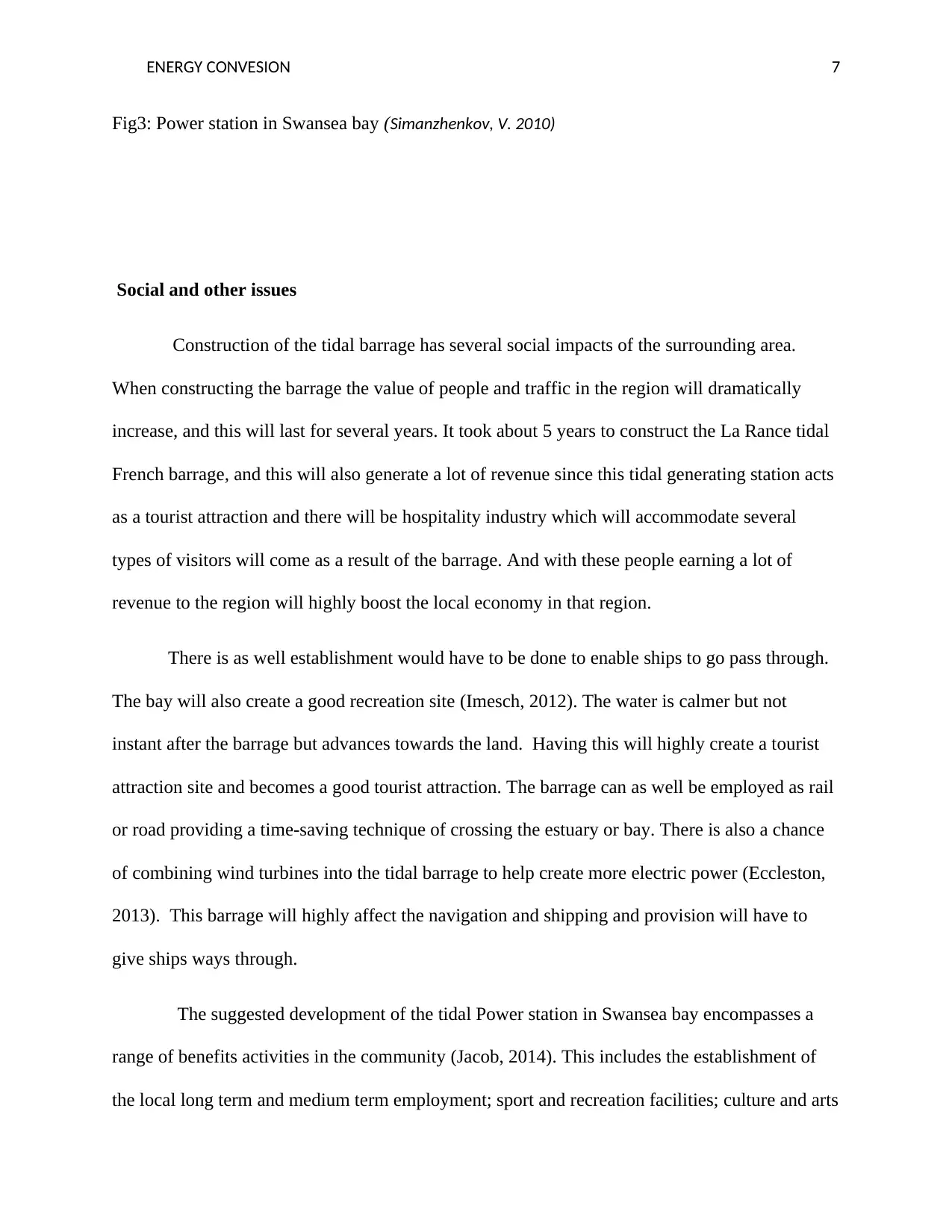
ENERGY CONVESION 7
Fig3: Power station in Swansea bay (Simanzhenkov, V. 2010)
Social and other issues
Construction of the tidal barrage has several social impacts of the surrounding area.
When constructing the barrage the value of people and traffic in the region will dramatically
increase, and this will last for several years. It took about 5 years to construct the La Rance tidal
French barrage, and this will also generate a lot of revenue since this tidal generating station acts
as a tourist attraction and there will be hospitality industry which will accommodate several
types of visitors will come as a result of the barrage. And with these people earning a lot of
revenue to the region will highly boost the local economy in that region.
There is as well establishment would have to be done to enable ships to go pass through.
The bay will also create a good recreation site (Imesch, 2012). The water is calmer but not
instant after the barrage but advances towards the land. Having this will highly create a tourist
attraction site and becomes a good tourist attraction. The barrage can as well be employed as rail
or road providing a time-saving technique of crossing the estuary or bay. There is also a chance
of combining wind turbines into the tidal barrage to help create more electric power (Eccleston,
2013). This barrage will highly affect the navigation and shipping and provision will have to
give ships ways through.
The suggested development of the tidal Power station in Swansea bay encompasses a
range of benefits activities in the community (Jacob, 2014). This includes the establishment of
the local long term and medium term employment; sport and recreation facilities; culture and arts
Fig3: Power station in Swansea bay (Simanzhenkov, V. 2010)
Social and other issues
Construction of the tidal barrage has several social impacts of the surrounding area.
When constructing the barrage the value of people and traffic in the region will dramatically
increase, and this will last for several years. It took about 5 years to construct the La Rance tidal
French barrage, and this will also generate a lot of revenue since this tidal generating station acts
as a tourist attraction and there will be hospitality industry which will accommodate several
types of visitors will come as a result of the barrage. And with these people earning a lot of
revenue to the region will highly boost the local economy in that region.
There is as well establishment would have to be done to enable ships to go pass through.
The bay will also create a good recreation site (Imesch, 2012). The water is calmer but not
instant after the barrage but advances towards the land. Having this will highly create a tourist
attraction site and becomes a good tourist attraction. The barrage can as well be employed as rail
or road providing a time-saving technique of crossing the estuary or bay. There is also a chance
of combining wind turbines into the tidal barrage to help create more electric power (Eccleston,
2013). This barrage will highly affect the navigation and shipping and provision will have to
give ships ways through.
The suggested development of the tidal Power station in Swansea bay encompasses a
range of benefits activities in the community (Jacob, 2014). This includes the establishment of
the local long term and medium term employment; sport and recreation facilities; culture and arts
Paraphrase This Document
Need a fresh take? Get an instant paraphrase of this document with our AI Paraphraser
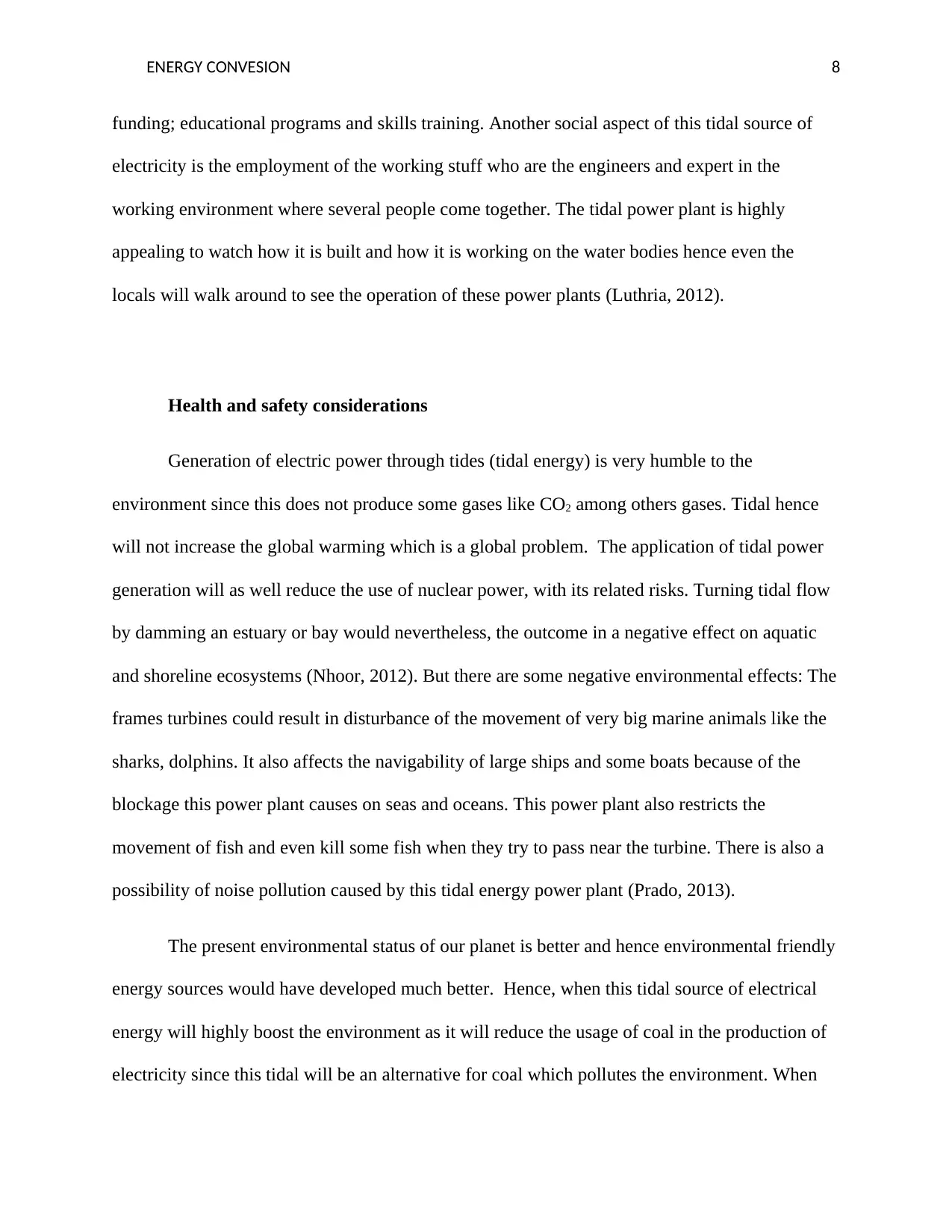
ENERGY CONVESION 8
funding; educational programs and skills training. Another social aspect of this tidal source of
electricity is the employment of the working stuff who are the engineers and expert in the
working environment where several people come together. The tidal power plant is highly
appealing to watch how it is built and how it is working on the water bodies hence even the
locals will walk around to see the operation of these power plants (Luthria, 2012).
Health and safety considerations
Generation of electric power through tides (tidal energy) is very humble to the
environment since this does not produce some gases like CO2 among others gases. Tidal hence
will not increase the global warming which is a global problem. The application of tidal power
generation will as well reduce the use of nuclear power, with its related risks. Turning tidal flow
by damming an estuary or bay would nevertheless, the outcome in a negative effect on aquatic
and shoreline ecosystems (Nhoor, 2012). But there are some negative environmental effects: The
frames turbines could result in disturbance of the movement of very big marine animals like the
sharks, dolphins. It also affects the navigability of large ships and some boats because of the
blockage this power plant causes on seas and oceans. This power plant also restricts the
movement of fish and even kill some fish when they try to pass near the turbine. There is also a
possibility of noise pollution caused by this tidal energy power plant (Prado, 2013).
The present environmental status of our planet is better and hence environmental friendly
energy sources would have developed much better. Hence, when this tidal source of electrical
energy will highly boost the environment as it will reduce the usage of coal in the production of
electricity since this tidal will be an alternative for coal which pollutes the environment. When
funding; educational programs and skills training. Another social aspect of this tidal source of
electricity is the employment of the working stuff who are the engineers and expert in the
working environment where several people come together. The tidal power plant is highly
appealing to watch how it is built and how it is working on the water bodies hence even the
locals will walk around to see the operation of these power plants (Luthria, 2012).
Health and safety considerations
Generation of electric power through tides (tidal energy) is very humble to the
environment since this does not produce some gases like CO2 among others gases. Tidal hence
will not increase the global warming which is a global problem. The application of tidal power
generation will as well reduce the use of nuclear power, with its related risks. Turning tidal flow
by damming an estuary or bay would nevertheless, the outcome in a negative effect on aquatic
and shoreline ecosystems (Nhoor, 2012). But there are some negative environmental effects: The
frames turbines could result in disturbance of the movement of very big marine animals like the
sharks, dolphins. It also affects the navigability of large ships and some boats because of the
blockage this power plant causes on seas and oceans. This power plant also restricts the
movement of fish and even kill some fish when they try to pass near the turbine. There is also a
possibility of noise pollution caused by this tidal energy power plant (Prado, 2013).
The present environmental status of our planet is better and hence environmental friendly
energy sources would have developed much better. Hence, when this tidal source of electrical
energy will highly boost the environment as it will reduce the usage of coal in the production of
electricity since this tidal will be an alternative for coal which pollutes the environment. When
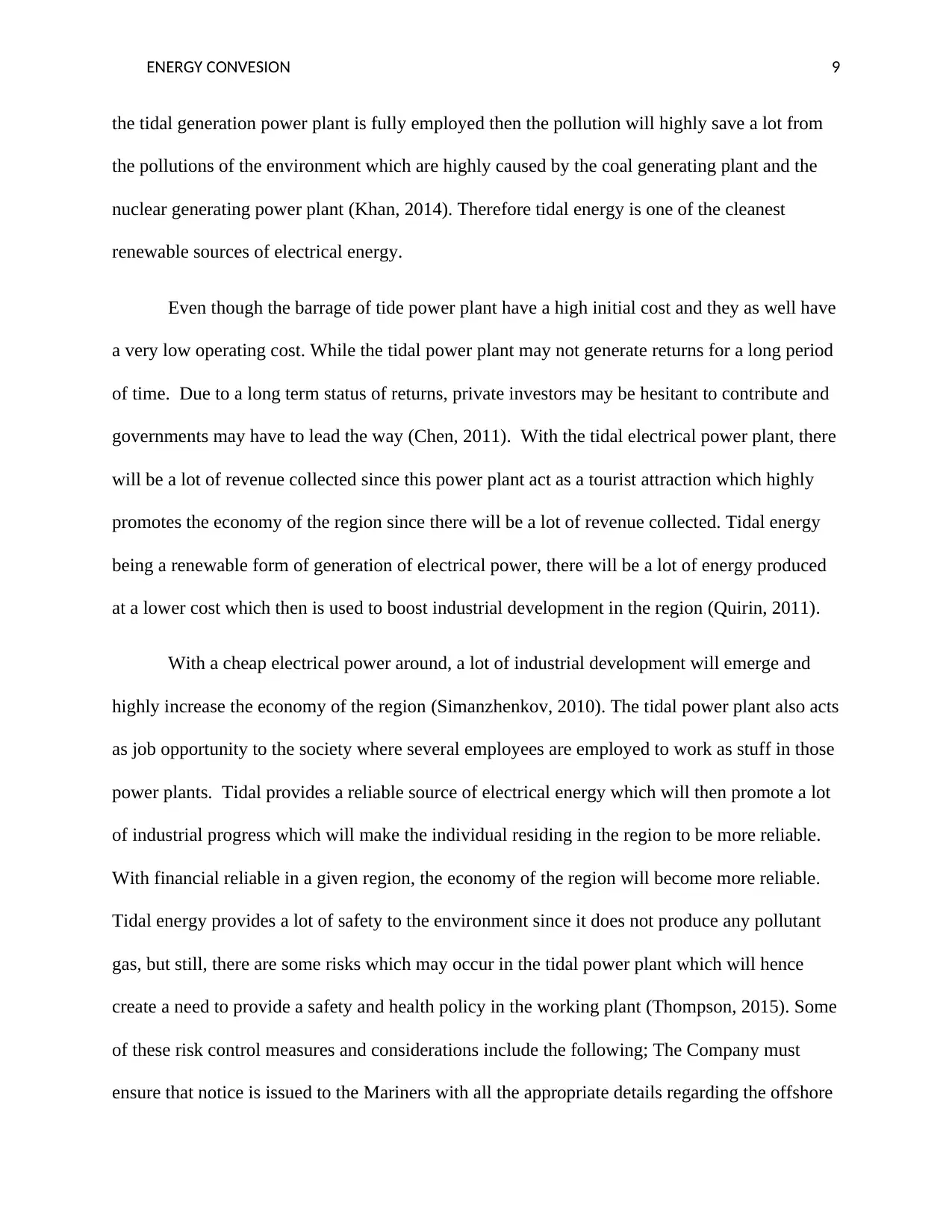
ENERGY CONVESION 9
the tidal generation power plant is fully employed then the pollution will highly save a lot from
the pollutions of the environment which are highly caused by the coal generating plant and the
nuclear generating power plant (Khan, 2014). Therefore tidal energy is one of the cleanest
renewable sources of electrical energy.
Even though the barrage of tide power plant have a high initial cost and they as well have
a very low operating cost. While the tidal power plant may not generate returns for a long period
of time. Due to a long term status of returns, private investors may be hesitant to contribute and
governments may have to lead the way (Chen, 2011). With the tidal electrical power plant, there
will be a lot of revenue collected since this power plant act as a tourist attraction which highly
promotes the economy of the region since there will be a lot of revenue collected. Tidal energy
being a renewable form of generation of electrical power, there will be a lot of energy produced
at a lower cost which then is used to boost industrial development in the region (Quirin, 2011).
With a cheap electrical power around, a lot of industrial development will emerge and
highly increase the economy of the region (Simanzhenkov, 2010). The tidal power plant also acts
as job opportunity to the society where several employees are employed to work as stuff in those
power plants. Tidal provides a reliable source of electrical energy which will then promote a lot
of industrial progress which will make the individual residing in the region to be more reliable.
With financial reliable in a given region, the economy of the region will become more reliable.
Tidal energy provides a lot of safety to the environment since it does not produce any pollutant
gas, but still, there are some risks which may occur in the tidal power plant which will hence
create a need to provide a safety and health policy in the working plant (Thompson, 2015). Some
of these risk control measures and considerations include the following; The Company must
ensure that notice is issued to the Mariners with all the appropriate details regarding the offshore
the tidal generation power plant is fully employed then the pollution will highly save a lot from
the pollutions of the environment which are highly caused by the coal generating plant and the
nuclear generating power plant (Khan, 2014). Therefore tidal energy is one of the cleanest
renewable sources of electrical energy.
Even though the barrage of tide power plant have a high initial cost and they as well have
a very low operating cost. While the tidal power plant may not generate returns for a long period
of time. Due to a long term status of returns, private investors may be hesitant to contribute and
governments may have to lead the way (Chen, 2011). With the tidal electrical power plant, there
will be a lot of revenue collected since this power plant act as a tourist attraction which highly
promotes the economy of the region since there will be a lot of revenue collected. Tidal energy
being a renewable form of generation of electrical power, there will be a lot of energy produced
at a lower cost which then is used to boost industrial development in the region (Quirin, 2011).
With a cheap electrical power around, a lot of industrial development will emerge and
highly increase the economy of the region (Simanzhenkov, 2010). The tidal power plant also acts
as job opportunity to the society where several employees are employed to work as stuff in those
power plants. Tidal provides a reliable source of electrical energy which will then promote a lot
of industrial progress which will make the individual residing in the region to be more reliable.
With financial reliable in a given region, the economy of the region will become more reliable.
Tidal energy provides a lot of safety to the environment since it does not produce any pollutant
gas, but still, there are some risks which may occur in the tidal power plant which will hence
create a need to provide a safety and health policy in the working plant (Thompson, 2015). Some
of these risk control measures and considerations include the following; The Company must
ensure that notice is issued to the Mariners with all the appropriate details regarding the offshore
⊘ This is a preview!⊘
Do you want full access?
Subscribe today to unlock all pages.

Trusted by 1+ million students worldwide
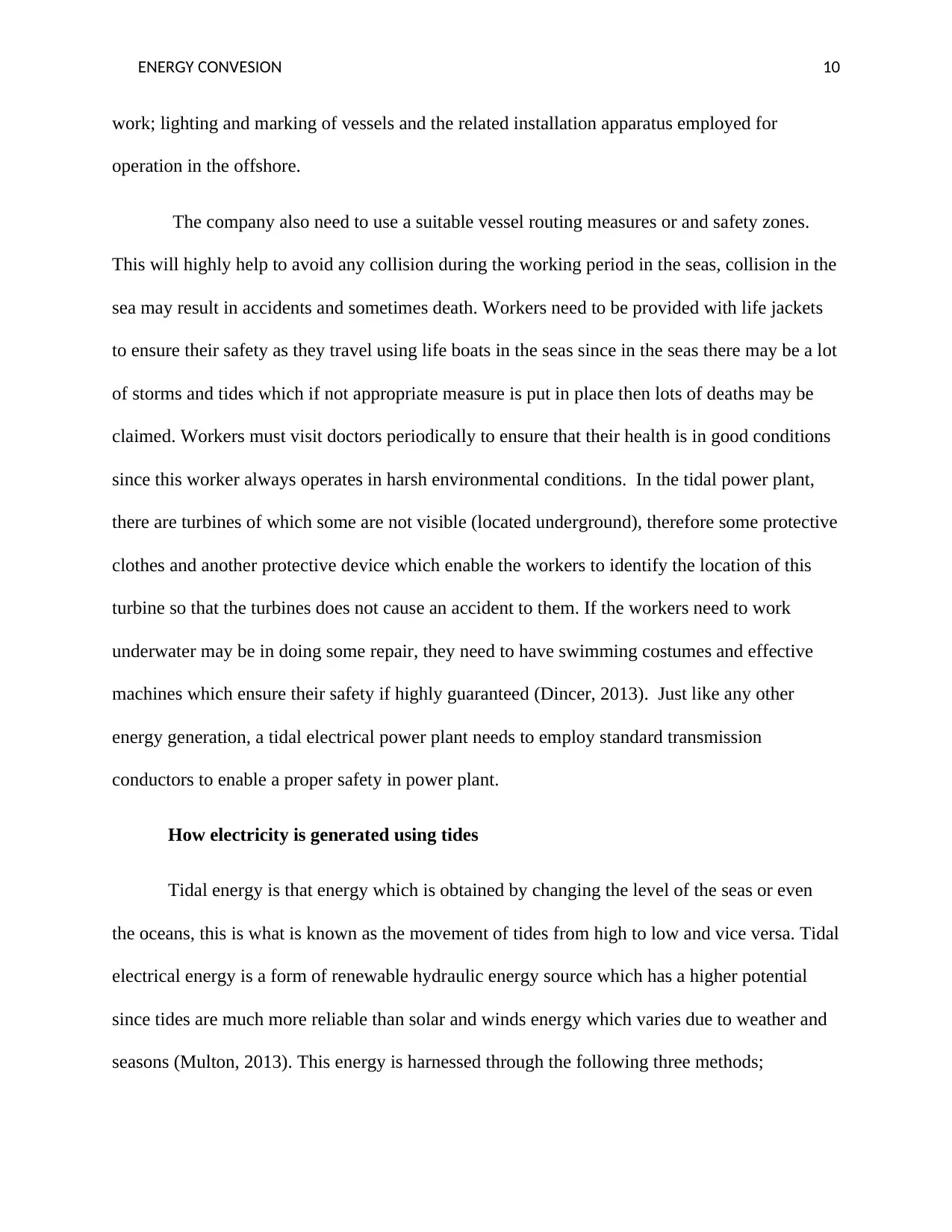
ENERGY CONVESION 10
work; lighting and marking of vessels and the related installation apparatus employed for
operation in the offshore.
The company also need to use a suitable vessel routing measures or and safety zones.
This will highly help to avoid any collision during the working period in the seas, collision in the
sea may result in accidents and sometimes death. Workers need to be provided with life jackets
to ensure their safety as they travel using life boats in the seas since in the seas there may be a lot
of storms and tides which if not appropriate measure is put in place then lots of deaths may be
claimed. Workers must visit doctors periodically to ensure that their health is in good conditions
since this worker always operates in harsh environmental conditions. In the tidal power plant,
there are turbines of which some are not visible (located underground), therefore some protective
clothes and another protective device which enable the workers to identify the location of this
turbine so that the turbines does not cause an accident to them. If the workers need to work
underwater may be in doing some repair, they need to have swimming costumes and effective
machines which ensure their safety if highly guaranteed (Dincer, 2013). Just like any other
energy generation, a tidal electrical power plant needs to employ standard transmission
conductors to enable a proper safety in power plant.
How electricity is generated using tides
Tidal energy is that energy which is obtained by changing the level of the seas or even
the oceans, this is what is known as the movement of tides from high to low and vice versa. Tidal
electrical energy is a form of renewable hydraulic energy source which has a higher potential
since tides are much more reliable than solar and winds energy which varies due to weather and
seasons (Multon, 2013). This energy is harnessed through the following three methods;
work; lighting and marking of vessels and the related installation apparatus employed for
operation in the offshore.
The company also need to use a suitable vessel routing measures or and safety zones.
This will highly help to avoid any collision during the working period in the seas, collision in the
sea may result in accidents and sometimes death. Workers need to be provided with life jackets
to ensure their safety as they travel using life boats in the seas since in the seas there may be a lot
of storms and tides which if not appropriate measure is put in place then lots of deaths may be
claimed. Workers must visit doctors periodically to ensure that their health is in good conditions
since this worker always operates in harsh environmental conditions. In the tidal power plant,
there are turbines of which some are not visible (located underground), therefore some protective
clothes and another protective device which enable the workers to identify the location of this
turbine so that the turbines does not cause an accident to them. If the workers need to work
underwater may be in doing some repair, they need to have swimming costumes and effective
machines which ensure their safety if highly guaranteed (Dincer, 2013). Just like any other
energy generation, a tidal electrical power plant needs to employ standard transmission
conductors to enable a proper safety in power plant.
How electricity is generated using tides
Tidal energy is that energy which is obtained by changing the level of the seas or even
the oceans, this is what is known as the movement of tides from high to low and vice versa. Tidal
electrical energy is a form of renewable hydraulic energy source which has a higher potential
since tides are much more reliable than solar and winds energy which varies due to weather and
seasons (Multon, 2013). This energy is harnessed through the following three methods;
Paraphrase This Document
Need a fresh take? Get an instant paraphrase of this document with our AI Paraphraser
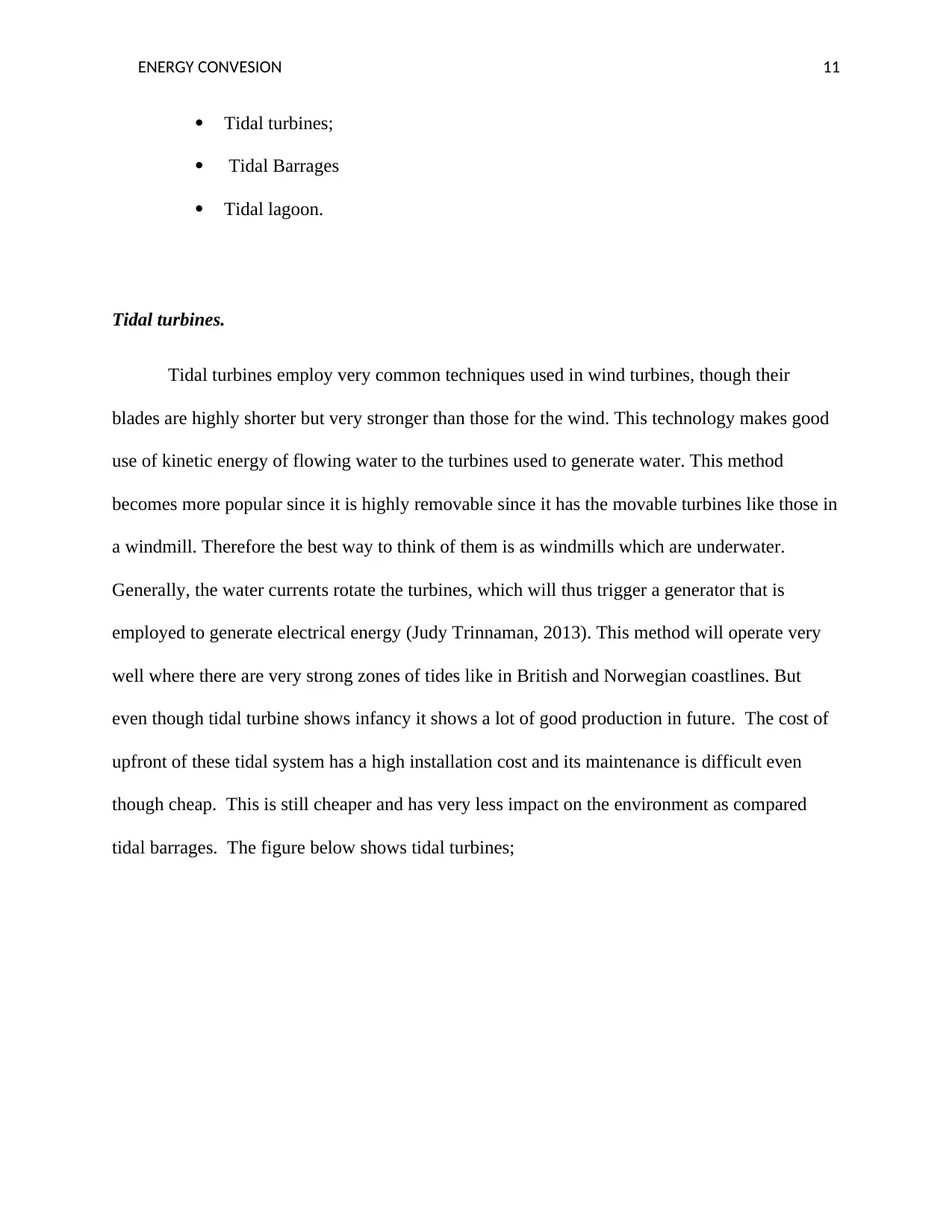
ENERGY CONVESION 11
Tidal turbines;
Tidal Barrages
Tidal lagoon.
Tidal turbines.
Tidal turbines employ very common techniques used in wind turbines, though their
blades are highly shorter but very stronger than those for the wind. This technology makes good
use of kinetic energy of flowing water to the turbines used to generate water. This method
becomes more popular since it is highly removable since it has the movable turbines like those in
a windmill. Therefore the best way to think of them is as windmills which are underwater.
Generally, the water currents rotate the turbines, which will thus trigger a generator that is
employed to generate electrical energy (Judy Trinnaman, 2013). This method will operate very
well where there are very strong zones of tides like in British and Norwegian coastlines. But
even though tidal turbine shows infancy it shows a lot of good production in future. The cost of
upfront of these tidal system has a high installation cost and its maintenance is difficult even
though cheap. This is still cheaper and has very less impact on the environment as compared
tidal barrages. The figure below shows tidal turbines;
Tidal turbines;
Tidal Barrages
Tidal lagoon.
Tidal turbines.
Tidal turbines employ very common techniques used in wind turbines, though their
blades are highly shorter but very stronger than those for the wind. This technology makes good
use of kinetic energy of flowing water to the turbines used to generate water. This method
becomes more popular since it is highly removable since it has the movable turbines like those in
a windmill. Therefore the best way to think of them is as windmills which are underwater.
Generally, the water currents rotate the turbines, which will thus trigger a generator that is
employed to generate electrical energy (Judy Trinnaman, 2013). This method will operate very
well where there are very strong zones of tides like in British and Norwegian coastlines. But
even though tidal turbine shows infancy it shows a lot of good production in future. The cost of
upfront of these tidal system has a high installation cost and its maintenance is difficult even
though cheap. This is still cheaper and has very less impact on the environment as compared
tidal barrages. The figure below shows tidal turbines;
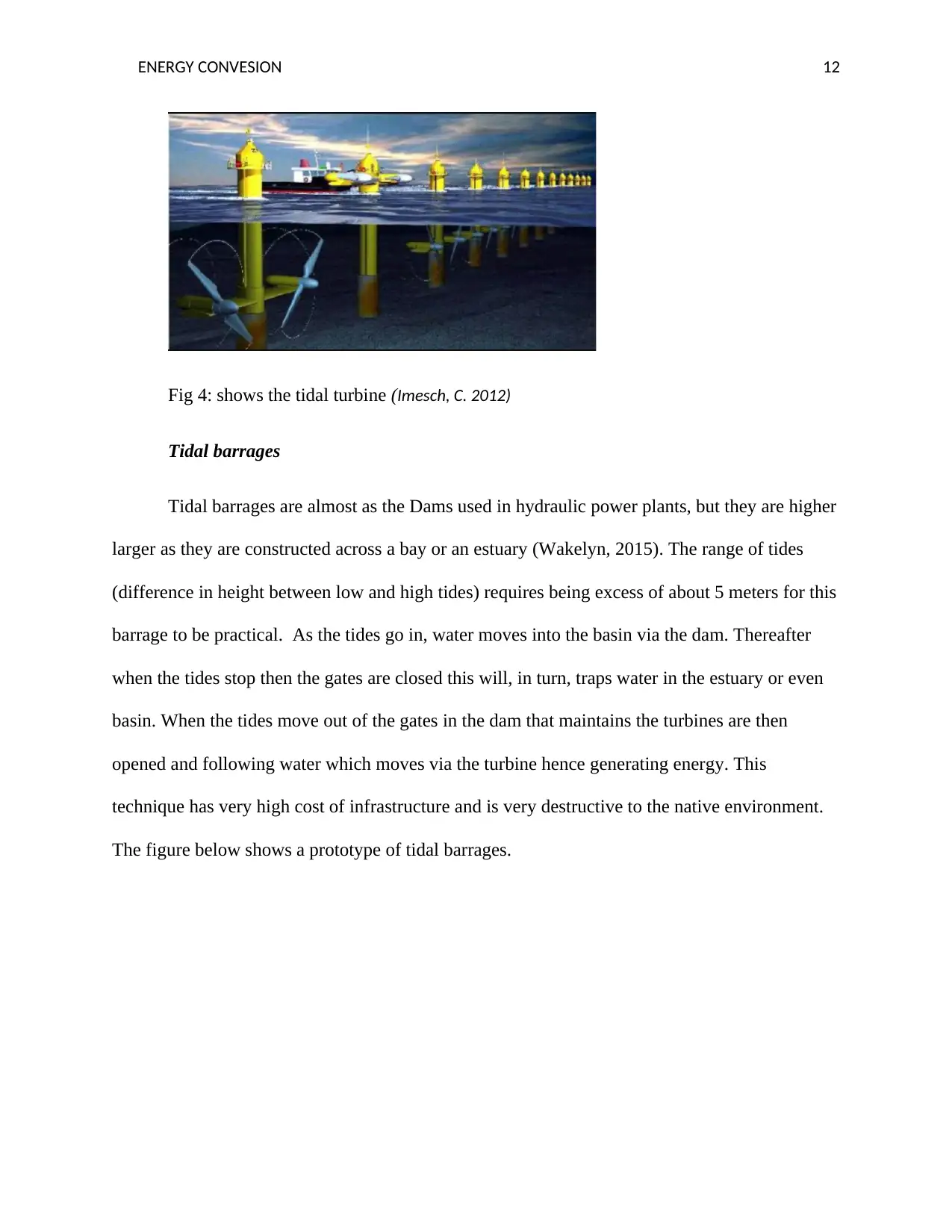
ENERGY CONVESION 12
Fig 4: shows the tidal turbine (Imesch, C. 2012)
Tidal barrages
Tidal barrages are almost as the Dams used in hydraulic power plants, but they are higher
larger as they are constructed across a bay or an estuary (Wakelyn, 2015). The range of tides
(difference in height between low and high tides) requires being excess of about 5 meters for this
barrage to be practical. As the tides go in, water moves into the basin via the dam. Thereafter
when the tides stop then the gates are closed this will, in turn, traps water in the estuary or even
basin. When the tides move out of the gates in the dam that maintains the turbines are then
opened and following water which moves via the turbine hence generating energy. This
technique has very high cost of infrastructure and is very destructive to the native environment.
The figure below shows a prototype of tidal barrages.
Fig 4: shows the tidal turbine (Imesch, C. 2012)
Tidal barrages
Tidal barrages are almost as the Dams used in hydraulic power plants, but they are higher
larger as they are constructed across a bay or an estuary (Wakelyn, 2015). The range of tides
(difference in height between low and high tides) requires being excess of about 5 meters for this
barrage to be practical. As the tides go in, water moves into the basin via the dam. Thereafter
when the tides stop then the gates are closed this will, in turn, traps water in the estuary or even
basin. When the tides move out of the gates in the dam that maintains the turbines are then
opened and following water which moves via the turbine hence generating energy. This
technique has very high cost of infrastructure and is very destructive to the native environment.
The figure below shows a prototype of tidal barrages.
⊘ This is a preview!⊘
Do you want full access?
Subscribe today to unlock all pages.

Trusted by 1+ million students worldwide
1 out of 19
Related Documents
Your All-in-One AI-Powered Toolkit for Academic Success.
+13062052269
info@desklib.com
Available 24*7 on WhatsApp / Email
![[object Object]](/_next/static/media/star-bottom.7253800d.svg)
Unlock your academic potential
Copyright © 2020–2025 A2Z Services. All Rights Reserved. Developed and managed by ZUCOL.





